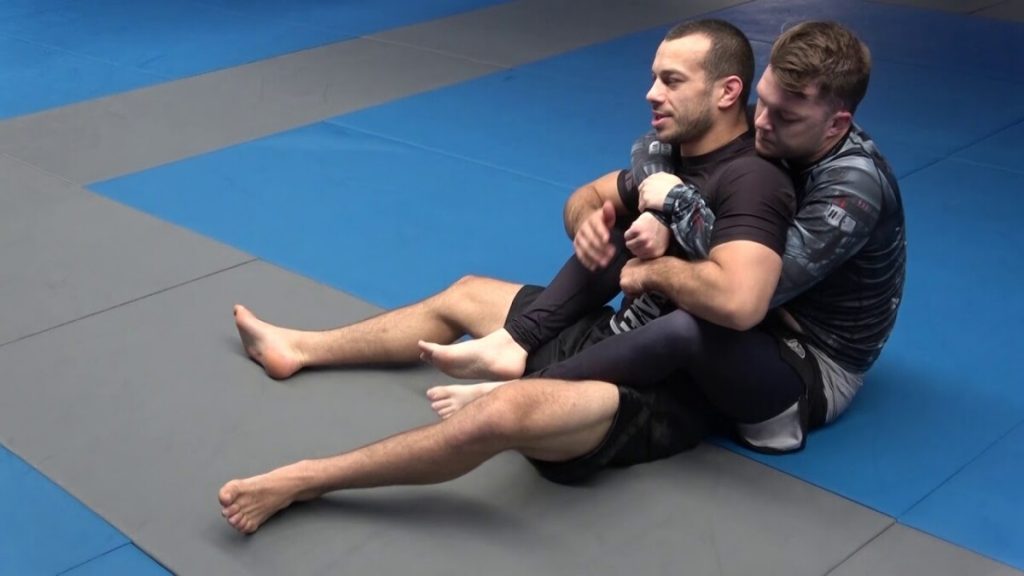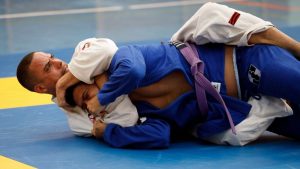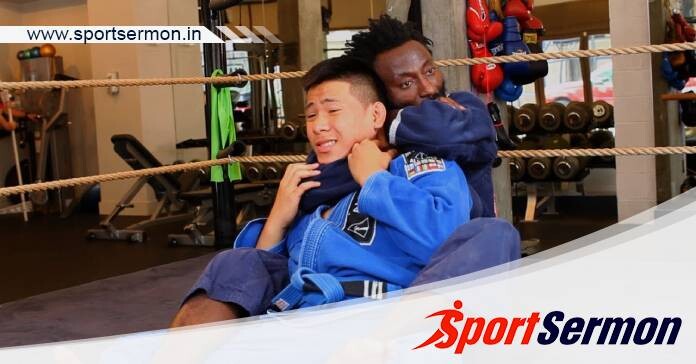Rear Naked Choke: One of the best submission moves ever created in Brazilian Jiu-Jitsu is the rear naked choke. Its Portuguese term, mata leão, which means “lion killer,” better describes the process than its English moniker. When done correctly, a blood choke can cause unconsciousness in as little as five seconds by cutting off the brain’s blood supply. It may be difficult to escape a properly held rear naked choke since you are forced to fight your opponent’s locked hands and much of their body is behind you.
We’ll go over all you need to know about the rear naked choke in this extensive article. This article can help you advance your RNC, regardless of your experience level—a white belt learning to submit for the first time or a seasoned black belt honing your craft.
What is The Rear Naked Choke?

To adequately defend against the rear naked choke, one must comprehend how it operates. Securing your opponent’s back, putting one arm around their neck, and then grasping your shoulder or bicep with the same arm are the steps in a rear naked choke. After that, you put your other hand behind their head and clench your elbows together to form a vice-like hold that stops their blood flow and causes them to tap out or go unconscious.
After discussing the fundamentals of how the rear naked choke operates, let’s look at some of the best strategies for stopping your opponent from locking on or for escaping after they have.
You might also be interested in reading this: The Von Flue Choke: What Is It?
Prompt Prevention
For good reason, the rear naked choke is known as the “lion killer” in Portuguese. It is a low-risk, high-reward strategy, and once you’re locked in, it’s very hard to get out. Learning to recognise when an opponent is searching for it will help you avoid being the victim of this tactic by allowing you to flee before it is secured.
1) Awareness of Position
The first step in escaping a rear naked choke is prevention. It’s crucial to pay attention to where you are and to avoid letting your opponent have the upper hand. In combat sports or actual conflicts, taking the other person’s back is one of the most powerful positions you can achieve, therefore never give it up lightly.
When you’re taken back, you have very few attacking options. Although it is limited to white belts, you can attempt the leg lock that every Brazilian Jiu-Jitsu teacher uses when you violate the cardinal rule and cross your legs after taking someone’s back.
The person on your back, meantime, has a wide range of options at their disposal, including rear-naked chokes and armbars. They can also use hefty strikes in self-defence and mixed martial arts to knock you down.
As you can see, it is quite detrimental to have someone on your back, thus take every precaution to keep opponents from doing so. A rear naked choke cannot be used to take you out without you giving up your back. The rear naked choke is more effective than certain chokes that are comparable and may be applied from the sides (such as the bulldog choke).
2) Fighting with the Hand
No matter how hard you attempt to repel them, certain opponents will inevitably get the better of you. It’s all part of the game, and just because you’re in a bad situation doesn’t mean you have to concede defeat right away.
As soon as your opponent takes your back, begin battling your arms to keep them from getting a firm hold on your neck.
Using both of your hands on one of your opponent’s hands is a common hand-fighting technique employed by many skilled fighters. Even though some skilled grapplers can execute a rear naked choke with one hand, it’s really tough, so you’re often safe if you just worry about one of your opponent’s arms. Ideally, you should concentrate on your opponent’s strong arm, making them attempt to secure the choke with their weaker arm or turn to find another target. It is also more difficult for adversaries to acquire a solid wrap around your neck when you tuck your chin down.
How to Escape the Choke?

After discussing a few strategies to stop opponents from obtaining a rear naked choke, let’s discuss some alternatives you have in case your opponent gets the better of you and locks it in:
1) Making Space
When your opponent has you engaged in a rear-naked chokehold, your first concern should be making room. Attempting to tuck your chin between the choke and bringing down the attacking arm with both hands can help you open up some space. Although it’s not a permanent fix, this can give you a few more seconds as you practise your escape. After relieving some of the chokes, use both of your arms to push your opponent’s choking arm aside and use all of your might to grab onto the other arm. In addition to releasing you from the choke, this should give you control over your opponent’s arm and thwart any further attempts at choking.
2) Sliding Off to the Side
Henry Atkins’s above example reveals another way to get out of the chokehold. In the latter levels of the game, if you ever find yourself stuck, try turning to your side to get out. Since the choke comes from behind, take advantage of the fact that your legs are free to move. Rotate your torso to make enough room.
3) Extracting the Cuffed Arm
Your next step should be to use your hand to push and pull on your opponent’s wrist or elbow to release their grasp because as long as they have their arm over your neck, you are still in danger. To give your opponent little time to respond to your manoeuvre, it should be swift and forceful.
Start pulling the constricting arm away from your neck while holding onto it. To release the hold, you can push against your opponent’s elbow or wrist using your hand.
Common Errors to Avoid with Rear Naked Chokes
Even though the RNC has a high success rate when executed correctly, little errors might let your opponent get away. Recognise these typical mistakes:
- Not putting enough depth in the arm over the neck
- Give them a loose grasp so they may take it off.
- Enabling room to seep out by keeping the hips and torso too far apart
- Failing to alter their stance, you ought to spread them out flat.
- Choking arm not tucked under the chin, but too high on the neck
- Burning out your arms sprinting to the finish line instead of taking your time to set up properly
In brief
Although escaping a rear naked choke might be difficult, it is doable with the correct methods and instructions. The keys include early avoidance, knowing how to make space, and employing the appropriate escape techniques.

